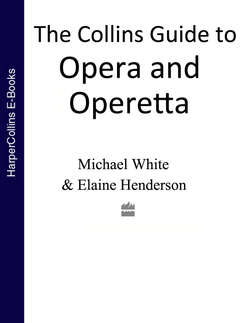Читать книгу The Collins Guide To Opera And Operetta - Michael White - Страница 8
ОглавлениеNixon in China
FORM: Opera in three acts; in English
COMPOSER: John Adams (1947–)
LIBRETTO: Alice Goodman
FIRST PERFORMANCE: Houston, 22 October 1987
Principal Characters
Richard Nixon, American president Baritone
Pat Nixon, his wife Soprano
Mao Tse-tung, Chinese statesman Tenor
Henry Kissinger, American statesman Bass
Chiang Ch’ing, Mao’s wife Soprano
Chou En-lai, Chinese statesman Baritone
Synopsis of the Plot
Setting: China; February 1972
ACT I On their arrival in Beijing, Nixon and his wife are greeted by Chou En-lai. Nixon feels that this visit is of great symbolic significance – as much as the first moon landing, in fact, and he also expresses his pleasure that their arrival coincides with peak television viewing time in America, thus ensuring him maximum publicity. Then the President, Henry Kissinger, Mao Tse-tung and Chou En-lai each offer their individual views on world issues, during which the contrasting ideologies and philosophies of East and West become evident, and the first act closes with a banquet.
ACT II Pat Nixon is taken to visit a commune and the Summer Palace and later joins the President, Mao, Chou En-lai and Mao’s wife, Chiang Ch’ing, to watch a performance of the contemporary ‘political ballet’, The Red Detachment of Women. This depicts a courageous group of women soldiers successfully battling against an unscrupulous landlord (played by Henry Kissinger). When the ballet ends, Chiang Ch’ing presents her account of the Cultural Revolution and how she sees her own place in history.
ACT III On the last night of the visit Nixon, Pat, Mao, Chiang Ch’ing and Chou En-lai are each seen in separate beds. Nixon and Mao reflect on past events in their lives and on their struggles to succeed. Nixon’s wartime memories centre on the acquisition of his own hamburger stand while Mao’s most vivid memories are the struggles of the Revolution. It is left to Chou En-lai to unite the past with the present by asking the question common to all political ideologies: ‘How much of what we did was good?’, which brings the opera to a close.
Music
Nixon in China is a mixture of exhilarating upbeat rhythms, pounding through the endless repetitions that make up a Minimalist score, and moments of reflective poignancy in which potentially cardboard characters really come to life. It isn’t easy to show recent historical figures with credibility on an opera stage, and the mere idea of Nixon and Mao singing to each other raises an assumption that the tone of the piece will be satirical. But no. Despite forays into the surreal, this is straight-laced all-American drama which if anything veers toward Romanticism – with appropriately luscious music. Even the synthesiser which Adams insinuates into the orchestral textures is given a romantic treatment.
Highlight
A brilliantly energised orchestral sequence called ‘The Chairman Dances’, which has entered the concert repertoire as a stand-alone piece.
Did You Know?
Nixon in China is one of the most commercially successful of all modern operas. The Grammy Award-winning recording was named a ‘recording of the decade’ by Time magazine, and the whole thing broadcast on American TV as though it were a newsflash, introduced by Walter Cronkite – which is probably the only time Richard Nixon ever saw it. He declined an invitation to attend the Houston premiere, and is not known to have been present at any other live performance.
Recommended Recording
Sanford Sylvan, James Maddelena, Chorus and Orchestra of St Luke’s/Edo de Waart. Nonesuch 7559 79177-2. The only recording to date.
